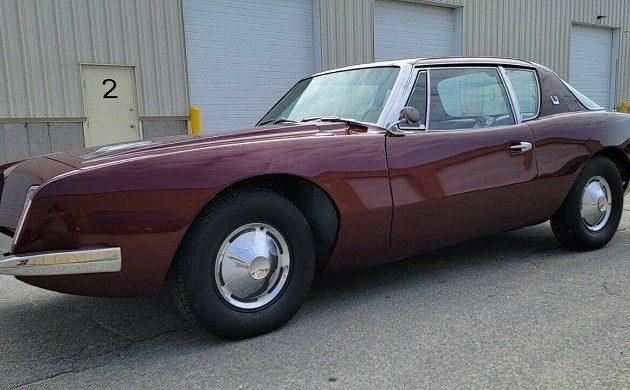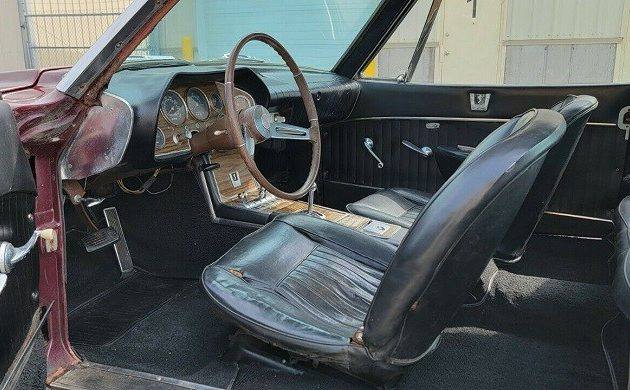As the story goes, the Avanti was conceived on a cocktail napkin by then Studebaker President Sherwood Egbert. From early 1961 to mid-1962, fast track development work was done to go from concept to a production-ready vehicle. Egbert had high hopes that the Avanti would help put Studebaker back on the map, but it was too little too late. Production of second-year Avanti’s ceased at the end of 1963 as Studebaker closed its manufacturing operations in the U.S. This rare 1964 model, one of 809 total built, was a one-family car that has just emerged from long-term storage. It’s going to need some work to be a regular runner, but it’s a solid example, to begin with. Located in Assonet, Massachusetts, this Avanti is available here on eBay where the latest bid stands at $10,100.
The Avanti was little changed going from 1963 into 1964, with the most noticeable being rectangular headlight bezels instead of round. The R1 Avanti had standard carburetion whereas the rarer R2 and R3 were supercharged, both using Studebaker’s 289 cubic-inch V8 engine. The cars were able to come to market so quickly because the decision was made to go with fiberglass bodies and to borrow from the existing Studebaker parts bin wherever possible. Management had planned to produce 20,000 copies a year, but early production delays and public concerns about the company’s financial health resulted in only 4,643 copies ever seeing the light of date, including 519 R1s from 1964.
This ’64 Avanti is a very nice car overall, but since it’s been in storage for years, some TLC will be needed. The Studebaker runs off an external gas can, but the fuel system is going to need to be flushed out. The brakes are also weak and will need some time in the shop, too. The odometer reading is 38,000 and there’s every reason to believe that’s accurate. The seller has tons of paperwork that will follow the automobile to its next home, including sales brochures, newsletters, dealer documents, a build sheet, and a title that’s dated in 1973 when the car no doubt passed from one family member to another. We’re told the body number is 4,172 which suggests it was put together toward the end of production.
The dark beauty has had one repaint which included a color change from Avanti Red to Avanti Maroon. The body looks straight, and we’re told there has never been any damage that needed repairing. Inside the passenger compartment, almost everything is good although there are a couple of tears in the front bucket seats. Hopefully, new material can be matched to the stellar back seat upholstery. The drivetrain is matching numbers including its 4-barrel carburetor. Open the trunk and you’ll find an assortment of spare parts. The Avanti is one of those rare cars that was revived after the company that built it went out of business. The Avanti II would be produced for 17 years beginning in 1965.






Wonder how the Hog Troughs are? I’m tempted
The very first thing to look at. Expensive to repair.
Always thought that it was clever of them to use Lark convertible frames, which already had sufficient bracing to counteract the lack of rigidity of the fiberglass body. Impressive swan song for an historic marque.
God, I love these Avantis! The design still looks modern today. The only thing I’d do to improve upon this beauty is to slap some whitewalls on it!
The Avanti was designed by Raymond Loewy, not Sherwood Egbert.
Rik,
You are correct, but the original basic concept/outline was said to come from Egbert.
Avantimotors.com says this:
Shortly after his appointment, while leaving on a business trip to California, Egbert purchased all of the automotive magazines he could find at O’Hare International Airport. Always restless and energetic, he began to read and sketch his vision of a new automobile for the corporation. He had been charged by the Corporation’s Board to strengthen its position in the automobile business. When he returned from his trip he called famed industrial designer Raymond Loewy.
Loewy had designed cars for Studebaker in the past but was astounded at the clarity and advanced looks of Egbert’s drawings. Loewy was quoted as having said “I did not know the man, but I read him through the sketches he handed me. I knew then that Egbert had a natural flair for design. I knew then that I was working for a man whom I could respect for his good taste.”
In just a short period, 10 days, Loewy gathered a team of designers consisting of John Epstein, Robert Andrews and Tom Kellogg. He hid them away in a rented house in the Mojave Desert just outside Palm Springs, California, where he resided. Incredibly, within a week the four designers had developed a 1/8-scale clay model of the proposed car. Loewy immediately returned to snowy South Bend with the model and presented it to Egbert. Thus began what was known at Studebaker as the “X-SHE” project ultimately called the “Avanti.”
Three weeks after this South Bend meeting, Egbert flew to California and reviewed the drawings and models that had been constructed. In about 20 minutes Egbert made a few minor changes and approved the final design. He then toasted the model with a chilled bottle of soda pop and simply said, “Lets go.”
The rest is history as we know it today! I believe the Avanti was the only production automobile to go from the basic 1/8 scale model and design drawings, to full scale production, with almost no changes. No bean counters or engineers were able to change the basic body designs. It’s truly as Loewy’s design group envisioned.